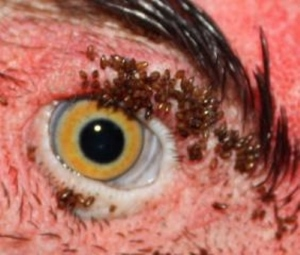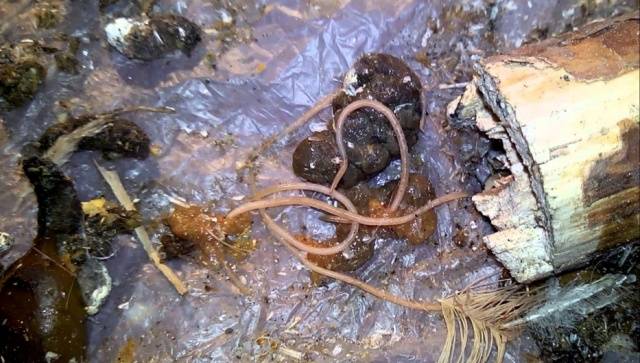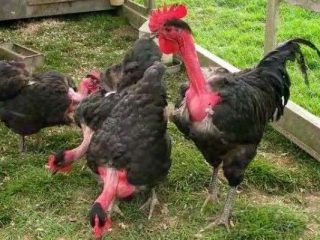Chickens suffer from external and internal parasites just as much as mammals. Interestingly, the types of parasites in all animals are almost the same; only the types of parasites differ, often having only one host. For example, a chicken lice eater cannot be found on a horse, and a horse lice eater cannot be found on a chicken. The most cosmopolitan in this regard are ticks and bedbugs, crawling on the heat emitted by a living organism.
Skin parasites in chickens are divided into two large groups: insects and arachnids. The first include down and feather eaters, often called chicken lice, bedbugs and fleas. Ticks are arachnid organisms. The drugs used to combat parasites are the same, but the life cycle and methods of reproduction are different. This makes it difficult to control external parasites in chickens.
External parasites of chickens
External parasites in chickens include:
- fleas;
- lice;
- bedbugs;
- downfeather-eaters;
- ticks.
Fleas and lice do not actually parasitize chickens, but the most dangerous bugs are the pigeon bug and the bed bug.
Moreover, each species of mammal is parasitized by its own “own” louse. Therefore, there cannot be lice on chickens. But non-specialists often confuse feather eaters with lice, guided by the principle “if a flea jumps, a louse doesn’t jump.”
In the photo on the left is a chicken feather eater, on the right is a head louse that parasitizes humans.
The parasites are similar and can be confused with inattentive examination, but the feather eater is longer and the head is wider than the chest. The louse has the opposite.
Feeding in chickens
Pere eaters belong to the order Mallophaga, while the louse belongs to the order Siphunculata. The main difference between these two insects is that the louse feeds on blood by biting the skin of the host, while the feather eater eats only the feathers. True, this doesn’t make it any easier for the chicken. Moving deep into the chicken's feather cover and clinging to the feathers and epidermis with its claws, the feather eater causes severe itching. The chickens begin to worry and peck themselves.
Without a magnifying glass, only a person who can see very small details with the naked eye can immediately distinguish a feather eater from a louse. For others, the feather eater looks like a louse and has a body length of 1.5 - 2.5 mm. Color yellow-brown. Here the difference from a louse is clearly visible. A hungry louse is light gray in color, while one that has drunk blood is dark brown.
Like a louse, the beetle lives permanently on its host. The female parasite can lay from 20 to 60 nits during her life. Transmission of the parasite from chicken to chicken occurs through direct contact between chickens or through mechanical transfer on staff clothing, care items, rodents and flies.
Symptoms of chicken infestation with feather eater
In chickens, feather eaters can be found on the combs and quills of feathers if the feather coverings are pulled apart.
When infected with a feather eater, chickens become restless and peck themselves due to itching. Feathers begin to fall out, leaving inflamed skin at the site of the loss. In chickens, growth and development stops, resistance to diseases. The diagnosis is made by finding the parasite on the chicken. If symptoms of parasite infestation are obvious, but the pereaters cannot be seen, use a damp brush to collect parasites from the skin, shake the brush over a sheet of white paper and examine what is collected under a microscope or magnifying glass. When the bird eaters can be collected in a group, the parasites become clearly visible even with poor eyesight.
Mites on chickens
Chickens can be attacked by both “ordinary” blood-sucking mites, whose main concern is to drink blood and reproduce in the environment, and by subcutaneous mites, which prefer to spend their lives on chickens. One type of subcutaneous mite infects chicken feet, causing knemidocoptic mange.
Knemidocoptosis
Scabies mites that settle under the scales of chickens' paws cause necrosis and raising of the scales on the chicken's paws. Lumps often develop. Because of the color of the dead scales of chicken feet, the disease received the popular name “lime foot.” The mite feeds on dead skin flakes and lymphatic fluid. Knemidocoptosis cannot be neglected, since in advanced cases, inflammatory processes caused by the vital activity of the mite lead to necrosis of the fingers on the mite-affected chicken feet.
If a mite is found on a chicken's feet, it is also necessary to check the rest of the chicken's body. Mites can spread under the wings and on the neck.
Chicken mite
Red chicken mite under high magnification.
Gamasid mite, bearing the Latin name Dermanyssus gallinae. In a hungry state, the size of a chicken mite is 3 quarters of a millimeter. The color is greyish.
A chicken mite that has drunk blood turns dark. The chicken mite is fairly easy to spot on a chicken, as the chicken mite prefers to attach itself to the skin in areas where blood vessels run very close to the surface. In the photo, chicken mites are located on the thin skin around the eyes. Chicken mites can also be found on the breasts and legs of chickens.
The chicken mite is a carrier of many dangerous infectious diseases of chickens. The dominance of chicken mites causes exhaustion and anemia in chickens, and also reduces egg production.
If the area is not completely infected with ixodid ticks, there will be no colonies of ixodid ticks on the chicken, but one parasite is enough to become infected with piroplasmosis. You cannot pull out an ixodid tick. When squeezed, the tick injects into the bloodstream all the microscopic parasites that are constantly present in the tick’s intestines. Remove the tick either with a special device or with a drop of oil. Oil that gets on the tick blocks the access of air to the spiracles. Gasping for breath, the tick climbs out on its own.
Bedbugs
Parasites that lead a crepuscular lifestyle and hide in crevices during the day. Bedbugs feed on the blood of warm-blooded organisms. Female bedbugs can only reproduce after drinking blood. Bedbugs and pigeon bugs are dangerous for domestic chickens.
Bedbugs lead a crepuscular lifestyle and attack chickens in the chicken coop in the evening and hide in cracks during the day. At the site of bedbug bites, you can observe skin irritation and self-biting, which chickens inflict on themselves due to itching and pain.
Externally, bedbugs are similar to ticks. Both parasites have a flattened shape, both are brown in color, and both swell when they drink blood. If you do not delve into the intricacies of entomology, parasites can easily be confused with each other.
Methods for controlling external parasites
All external parasites can be killed using standard modern flea and tick treatments designed for pets. These drugs can also be used on chickens, adjusting for the weight of the bird. That is, if the ampoule is intended for a cat weighing 4–5 kg, and the weight of the average laying hen is 1.5 kg, the ampoule must be divided into 3 hens. But this is subject to a small number of chickens in the yard.
If there are a lot of chickens, aerosol spraying is used. Concentrated preparations, such as neostomazan, stomazan, butox and other analogues, are diluted in water according to the instructions and the chickens are pollinated with this solution. Similar products are sold in a pet store or veterinary pharmacy. Preparations intended for complete treatment of poultry farms, including all chickens, against parasites are not sold in regular stores.
In a series of videos, the author shows how he fights either a chicken mite or a bedbug. The habits of these two parasites are similar, and so are their methods of control. The author himself believes that he is fighting a tick.
How to get rid of chicken mites or bedbugs
The best option to get rid of parasites in the chicken coop is to throw a sulfur bomb there. Sulfur smoke is guaranteed to kill all living things, even in those crevices where fire cannot reach. Using a sulfur bomb, you can not only carry out disinfestation, but also disinfection of the chicken coop. Such checkers are inexpensive, but they have a drawback: there should not be any necessary living creatures in the room when using the checker. The chickens will have to be moved to another location for a couple of days.
Folk remedies for treating chickens against external parasites
It would be more appropriate to call folk remedies methods of prevention against parasite infection, rather than treatment. The most effective of all is a basin of ash, in which chickens bathe, getting rid of ticks and feather eaters. There are often tips on how to get rid of parasites using certain herbs, such as wormwood or tansy. Experience shows that the smell of freshly picked grass can scare away only fleas, which are not eager to communicate with chickens anyway. All other parasites will only rejoice at the appearance of such a cozy place for an ambush. Even fleas are not afraid of dried grass. Therefore, the best option would be to systematically treat chickens and poultry houses with preparations designed to kill insects.
Internal parasites of chickens
Internal parasites, also known as worms, are divided into three groups: flat, tape and round. Worms are not only those that live in the gastrointestinal tract, but also those that settle in the liver, lungs and even the circulatory system. The largest of them are intestinal worms. Often these worms can be easily seen with the naked eye.
Chickens become infected with worms, as a rule, by eating shellfish while walking in the wild. Chickens can also become infected from each other. This is especially true for chickens that try to peck everything.
The roundworm above in the photo can be called the lightest of all types of worms. Getting rid of roundworms is quite simple. Theoretically, even folk remedies in the form of garlic can work, but it is better to use medications. Garlic does not always work against worms, and even roundworms can kill their owner if too many worms accumulate in the intestines.
Symptoms of chicken infestation with worms can be:
- exhaustion;
- yellow diarrhea;
- pale comb and earrings;
- decreased egg production of chickens;
- the appearance of soft-shelled eggs;
- general weakness;
- loss of appetite or, conversely: increased appetite with progressive exhaustion.
With ascariasis, constipation is an alarming sign; it can be caused by roundworms huddled together in a ball. In this case, it is recommended to slaughter the chicken, since the ball of worms will not come out on its own, and abdominal operations are not performed on chickens.
Chickens affected by worms may fall on their feet due to weakness.
Due to constant diarrhea caused by parasites, the soiled skin around the cloaca becomes inflamed in chickens.
Ascariasis is the most common helminthic disease. Its main danger is intestinal obstruction in chickens. Much more exotic is drepanidoteniasis, caused by tapeworms.
Drepanidoteniasis
Symptoms: intestinal dysfunction; impaired coordination of movements; at the end of the disease there is paralysis.
Tapeworms are much more difficult to get rid of than round worms, and garlic is no help here. The danger of tapeworms is that even with the use of sufficiently strong anthelmintic drugs, the worm can shed its entire body, leaving only the head attached to the wall of the chicken intestine. From the head of the worm, the segments of the parasite's tape body will grow back.
Thus, getting rid of the tape parasite using folk remedies is impossible, but modern drugs, at a minimum, involve control over the vital activity of the worm.
Do chickens need to be treated for worms, how often and with what medications?
When treating chickens with anthelmintics, owners rid the birds of worms only temporarily. Sooner or later, these parasites will infect chickens again. However, deworming is necessary to maintain chicken productivity.
Due to the fact that broilers have a lifespan of 2 months, regular deworming for these chickens is not relevant. It is enough to carry out treatment against parasites according to indications. Laying hens need to be dewormed once every 4 months, since even hens that are not roaming can become infected with worms through contaminated feed or from rats.
After deworming, all bedding of the chickens is cleaned, and the floor and, preferably, the walls of the chicken coop are thoroughly disinfected to destroy parasite eggs. The litter and droppings are burned.
Conclusion
Worms cause significant economic damage to chicken farmers, but methods of combating them have been developed.It is much more difficult to deal with bedbugs and ticks, which hide in any crevice that is difficult for the eye to see. Without the use of sulfur smoke, the parasites' refuge will certainly be missed. These parasites multiply very quickly. A few days are enough for the parasite population to recover.



















